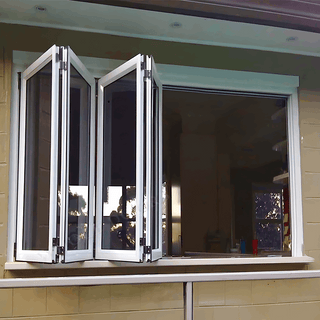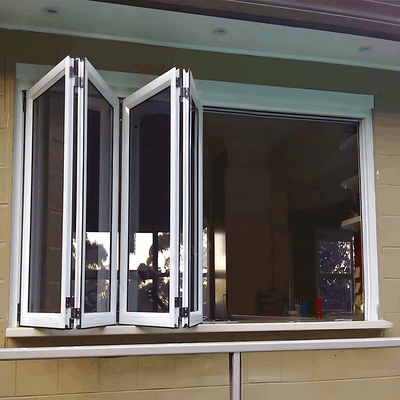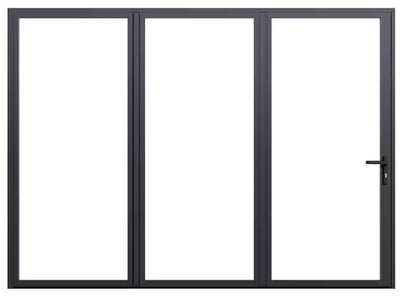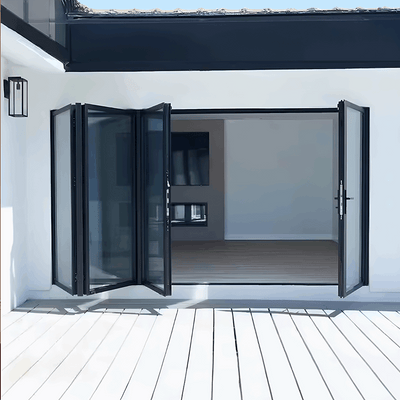Getting Your Arsenal Ready: Essential Tools That Actually Work
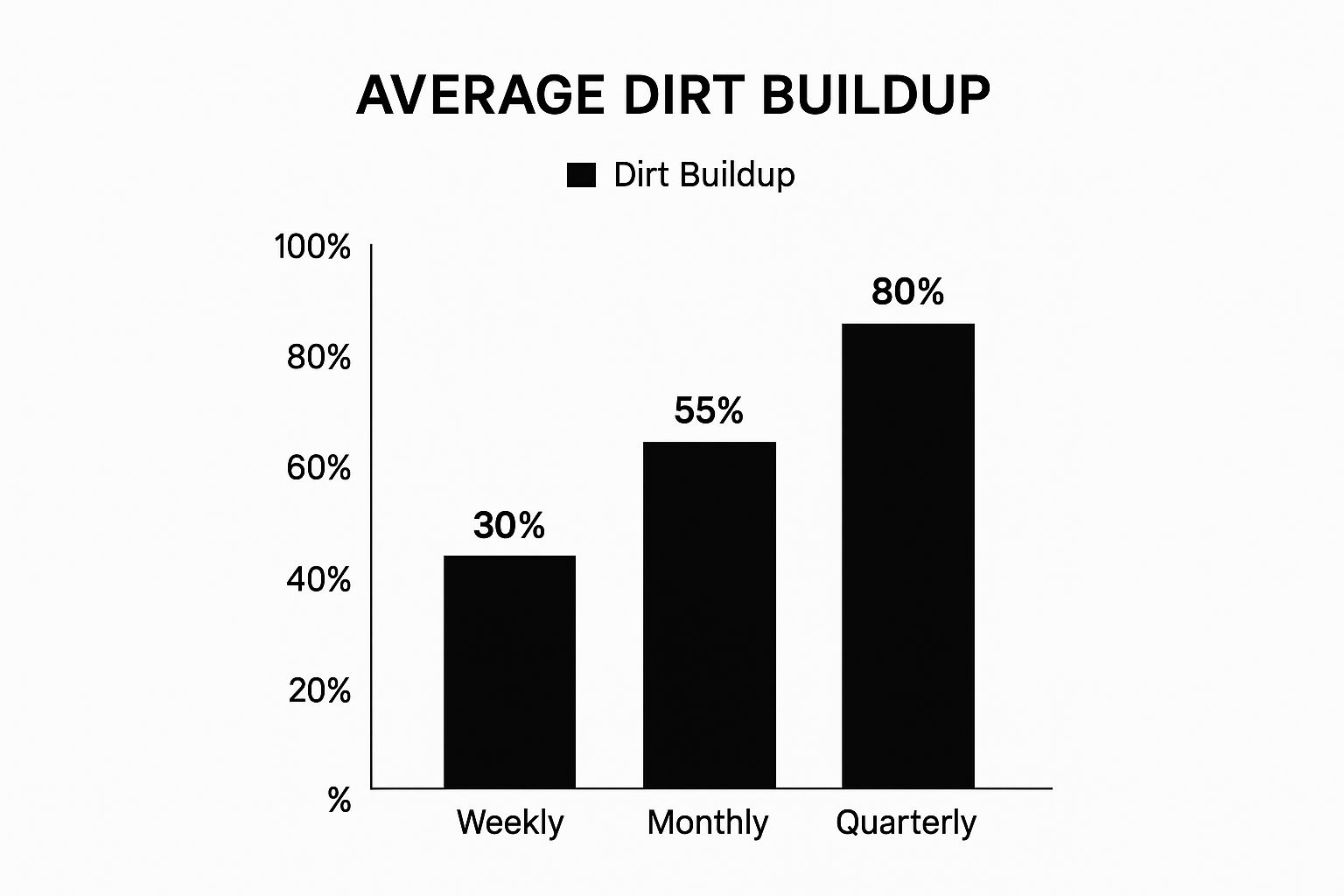
This infographic shows how much dirt builds up on your windows depending on how often you clean them. Weekly cleanings keep the grime down to about 30%, while monthly cleanings see about 55% buildup. Let it go a whole quarter, and you're looking at 80%! Regular upkeep is key, and it makes cleaning large windows way less of a chore. Speaking of which, let's talk tools. For a deeper dive into window cleaning in general, check out this helpful window cleaning guide.
Choosing the Right Squeegee
First things first: a good squeegee is essential. You don't need anything fancy. I've been using a basic $15 squeegee with replaceable blades for years, and it works perfectly. The secret is a sharp, quality blade, not a hefty price tag.
Pair your squeegee with an extension pole, especially for those high-up spots on large windows. It's a lifesaver for your back, and it helps you apply even pressure across the whole window.
Microfiber Cloths and Buckets
Microfiber cloths are your best friend for wiping the squeegee blade and getting a streak-free finish. I'm a big fan of the waffle-weave kind; they just seem to grab dirt and water better. You'll also need a good, sturdy bucket. I use a 5-gallon bucket with a grit guard – keeps the cleaning solution nice and clean.
A spray bottle comes in handy for applying the solution directly to the window, especially if it's really dirty. For those extra stubborn bits, a scraper can gently remove gunk without scratching the glass. And don't forget safety glasses! You want to protect your eyes from any splashing cleaning solution. While we’re on the topic of windows, this article on energy-efficient windows might be of interest.
Having the right tools really does make a difference. It makes the whole process smoother, safer, and so much more satisfying.
Before we move on, let’s take a look at this helpful table comparing some of the key tools we've talked about. It gives you a quick overview of price ranges, effectiveness, and what each tool is best suited for.
Large Window Cleaning Tool Comparison A comprehensive comparison of essential tools showing price ranges, effectiveness ratings, and best use cases
| Tool Type | Price Range | Effectiveness | Best For |
|---|---|---|---|
| Squeegee | $10-$30 | High | Cleaning large glass surfaces |
| Extension Pole | $20-$50 | High | Reaching high windows |
| Microfiber Cloth | $5-$15 | High | Wiping and detailing |
| Bucket with Grit Guard | $15-$30 | Medium | Holding and cleaning solution |
| Spray Bottle | $5-$10 | Medium | Applying cleaning solution |
| Scraper | $5-$15 | Medium | Removing stubborn debris |
| Safety Glasses | $10-$20 | High | Protecting eyes |
As you can see, effective window cleaning doesn't have to break the bank. Investing in a few key tools will make a world of difference in your cleaning routine. With the right gear, you're well on your way to sparkling clean windows.
Staying Safe While Reaching New Heights
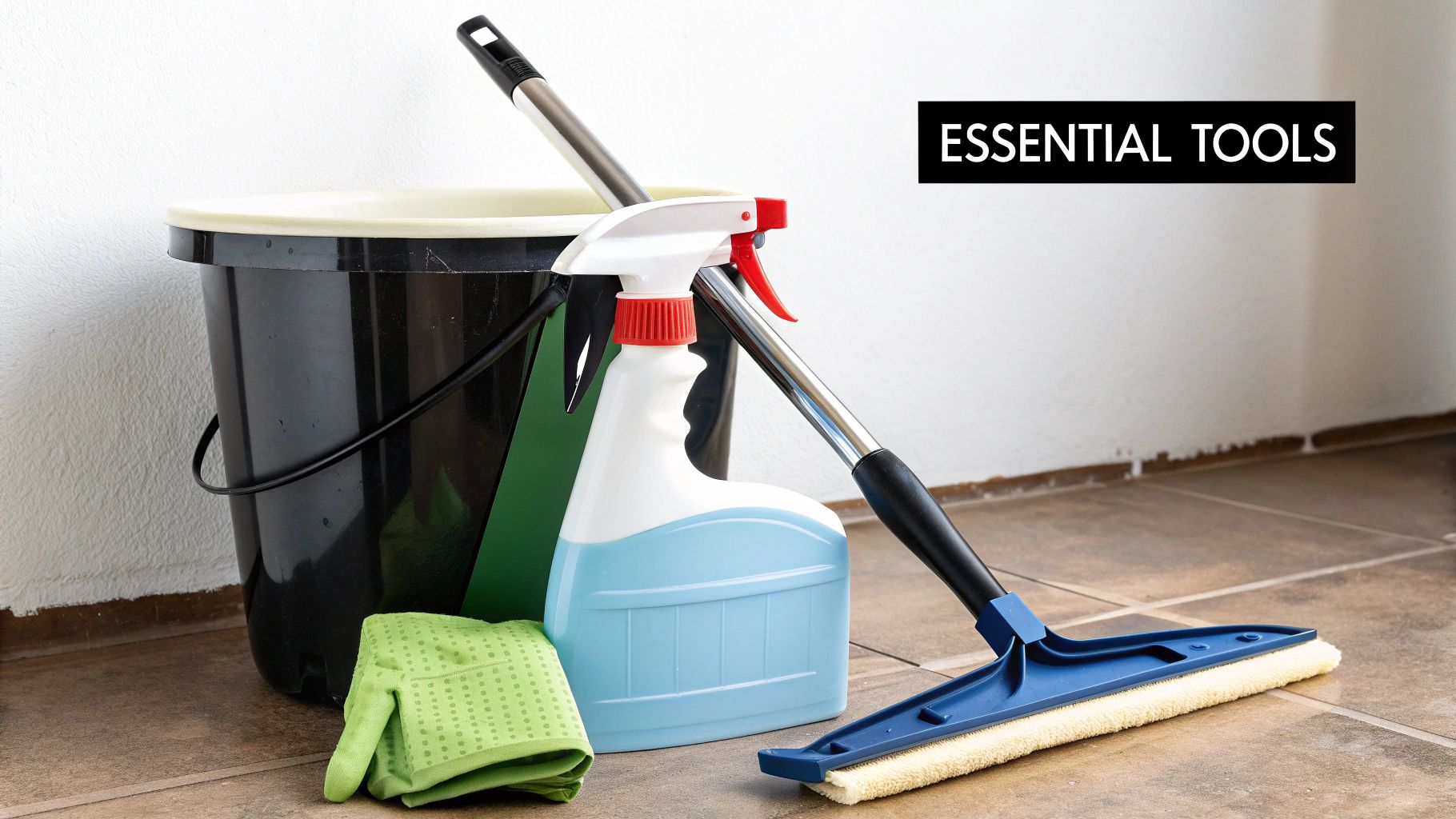
Let's be honest, cleaning large windows, especially those higher up, can be a bit nerve-wracking. It's not just about sparkling glass; it's about making sure you're safe while you're up there. So, before we even get to the cleaning solutions, let's talk about having the right tools and the right mindset. Having the right equipment makes a world of difference, and you might find some useful cleaning and safety equipment ideas by looking into auto detailing equipment.
Ladder Safety 101
If you're using a ladder, make sure it's the appropriate height. It absolutely needs to extend at least three feet above the roofline if you’re planning to go up onto the roof. Place it on solid, level ground—no wobbly situations allowed. And, if you can, always have a spotter. I learned this lesson the hard way once. The ground seemed fine, but it shifted just enough, and I nearly went down. Believe me, a spotter is invaluable.
Having someone there to hold the ladder steady and keep an eye out is a game-changer. It not only adds to your safety, but also gives you that extra bit of confidence when you're reaching for those higher spots.
The Power of Extension Poles
Now, for those of you who aren't crazy about heights (like me!), extension poles are your new best friend. Especially for second-story windows and those tricky picture windows, they let you clean effectively from the ground. No ladder needed! It makes the whole process much less daunting and much more efficient.
This is my go-to method for most large window cleaning tasks. It’s so much easier to maneuver the cleaning tools from the ground and get those windows sparkling without having to worry about balance.
Knowing Your Limits
Sometimes, the best thing you can do is know when to call in the pros. If you’re not comfortable with heights or if the setup seems a bit precarious, don’t hesitate to call a professional window cleaner. It's not worth risking your safety. There are lots of trained professionals out there who handle these situations every day. Interestingly, the window cleaning industry is quite substantial. In North America alone, there are over 12,244 window cleaners in the US and Canada, with an average age of 48 years. This tells you something about the experience and physical demands involved. You can discover more insights if you're curious.
These professionals have the right equipment and the experience to tackle even the most challenging windows safely and efficiently.
Protecting Your Property
While you're focused on those gleaming windows, don't forget about everything around them. Cover your bushes and flowerbeds with drop cloths to protect them from the cleaning solution. And be mindful of window screens and any decorative details. A few minutes of preparation can prevent accidental damage. With these precautions in place, you can confidently tackle those large windows and achieve a sparkling clean finish without any mishaps.
Finding the Perfect Cleaning Solution for Your Glass
I've learned something surprising over the years: not all windows are created equal when it comes to cleaning solutions. From antique single-pane windows to modern Low-E coated glass, I’ve cleaned them all, and trust me, the cleaner you choose can dramatically affect your results. Think of it like cooking – you wouldn't use the same spices on everything, right?
Simple Solutions vs. Professional Grade
Let’s start simple. For lightly soiled windows, a mix of dish soap and water often does the trick. A few drops of Dawn in a bucket of warm water is surprisingly effective in my experience. It's gentle, easy to find, and usually doesn't leave streaks.
But for truly grimy windows, especially those exposed to the elements, you might need to bring in the big guns. Professional-grade cleaning solutions are designed to cut through tough dirt, bird droppings, and even stubborn tree sap. These are lifesavers for windows that haven't seen a good cleaning in a while. Just remember to test any new cleaner on a small, hidden area first to make sure it won’t damage your glass or any special coatings.
DIY Cleaning Solutions
If you're like me and prefer a more natural approach, you can easily make your own cleaning solution. A classic mix of white vinegar and water is a go-to. The vinegar's acidity helps dissolve mineral deposits and grime, leaving your windows sparkling clean. I like to add a few drops of essential oil – lemon or tea tree – for a fresh scent.
Another DIY option is a paste of baking soda and water. It acts as a gentle abrasive to tackle stubborn spots. Just apply it with a soft cloth, let it sit for a few minutes, and then rinse well. Not only are these homemade solutions effective, they’re also kind to the environment.
Understanding Your Windows
The type of glass you have also plays a role in choosing the right cleaner. If you have Low-E coated windows, take extra care. These windows have a special coating that reflects heat, and harsh chemicals can damage it. Stick to gentle solutions like dish soap and water or a cleaner specifically formulated for Low-E glass.
Even the weather can influence how well your cleaning solution works. In hot, sunny weather, the solution can dry too quickly and leave streaks. Cleaning on a cloudy day or in the shade is usually best. Also, consider the pH level of your cleaner. A neutral pH is generally ideal, but a slightly acidic solution, like the vinegar mix, can help dissolve mineral buildup.
Finding the right cleaning solution for your large windows might take a little trial and error, but it’s worth it for a streak-free shine every time. Once you’ve got that sorted, you're ready for the actual cleaning, which we'll get into next.
Mastering the Art of Streak-Free Cleaning
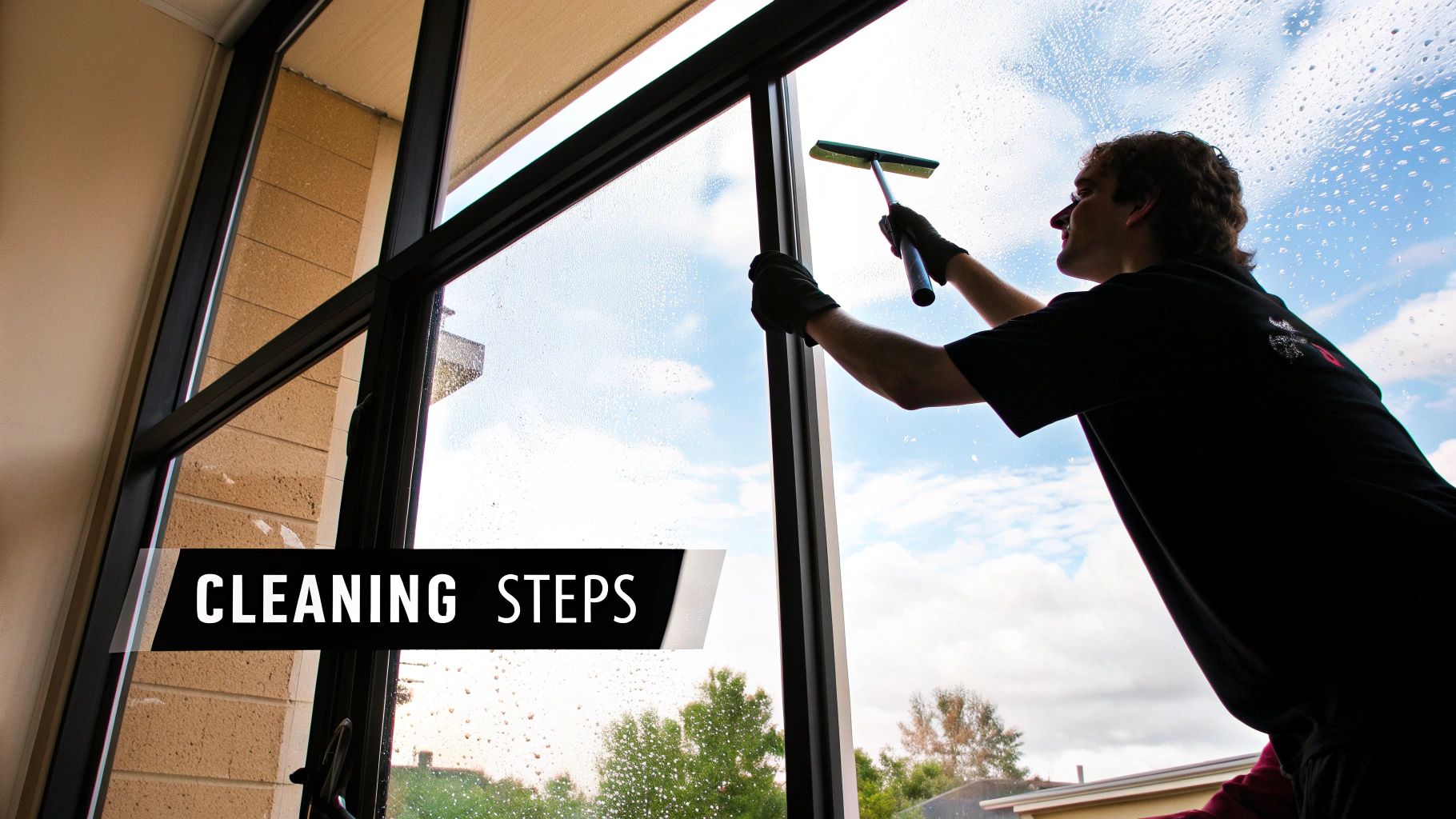
So, you’ve got your tools gathered and safety is top of mind. Excellent! Now comes the fun part: turning those grimy large windows into gleaming, streak-free beauties. Let me tell you, I've spent enough weekends wrestling with my own windows to pick up a few pro tips along the way, and I'm happy to share what I've learned.
The Squeegee: Your Secret Weapon
The key to a streak-free shine? Mastering the squeegee. It's not as intimidating as it sounds. First, drench the window with your cleaning solution. Then, hold your squeegee at a slight angle and make an overlapping stroke from top to bottom. Here’s the crucial bit: wipe the blade clean with your microfiber cloth after every single stroke. Check out this article for some extra tips: cleaning large windows expert tips and tricks.
This overlapping technique prevents those annoying streaks of dirty solution. It’s a small detail that makes a huge difference. Also, keep consistent pressure on the squeegee for an even, clean finish.
Handling Large Surfaces and Window Grids
Got a massive window to tackle? Don’t worry, you don't have to do it all in one go. Break the window down into smaller, more manageable sections. Think of it like mowing the lawn – you wouldn't try to mow your entire yard in one pass! Working in sections keeps the cleaning solution from drying and streaking before you can get to it.
Now, window grids. Those can be a bit fiddly. A smaller squeegee can be your best friend here, or you can carefully navigate your regular squeegee around the grids. Personally, I find a combination of both methods works best.
Timing and Detailing
Timing is key with large windows. Work quickly, but with precision. Don't let the cleaning solution dry on the glass. As soon as you’ve squeegeed a section, dry any remaining edges with a clean, dry microfiber cloth. This prevents drips and adds that final polished touch. And speaking of solutions, make sure you're using the right one for your windows! You can find more info on appropriate cleaning solutions here.
These small details are what elevate your window cleaning from good to great. It’s all about taking that extra time to make sure every nook and cranny is sparkling.
The Economics of Window Cleaning
Ever considered hiring a pro? Cleaning windows for an average 1,500-square-foot house costs around $260, usually falling somewhere between $150 and $370. The number of windows, how high they are, and how easy they are to reach will affect the final price. This information can be helpful in deciding if DIY is worth the effort, particularly if you’re dealing with a lot of large windows. Discover more insights.
Mastering these techniques will transform those challenging large windows into a source of true satisfaction. Trust me, nothing beats the feeling of sunshine streaming through perfectly clean glass.
Conquering Your Toughest Window Challenges
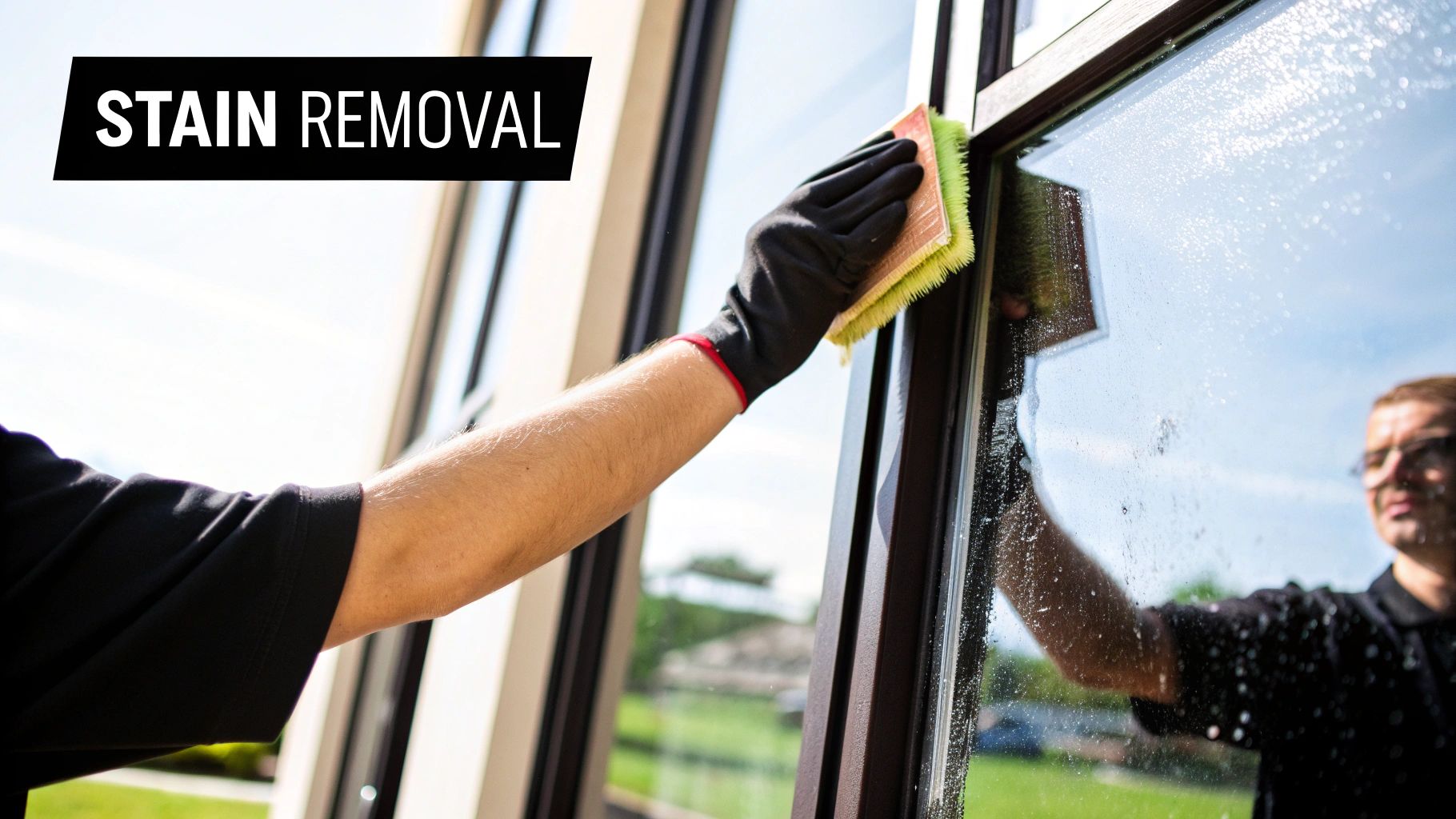
Let's be honest, cleaning large windows can sometimes feel like a Herculean task. Years of dust, stubborn hard water stains, and the occasional bird dropping can make them look downright grimy. Trust me, I've been there, scrubbing away at what seemed like permanent window tattoos. But don't worry, I've also figured out some tricks to conquer even the most stubborn window challenges, and I'm happy to share.
Removing Stubborn Buildup
Forget that wimpy dish soap solution when you're facing serious buildup. My go-to for windows that haven't seen a cleaning rag in ages? A paste of baking soda and water. Seriously, it works wonders. Just mix it up, apply it to the grime, and let it sit for a few minutes to soften things up. Then, gently scrub with a soft cloth or sponge, rinse well, and prepare to be amazed.
Handling Damaged Seals and Scratches
Sometimes, the dirt isn't the real problem. Damaged seals can trap moisture and grime, creating a real mess. In this case, you might need to bite the bullet and replace the seal. While you're at it, you might want to check out this helpful guide on how to stop window condensation. Condensation can often be a sign of a bigger problem.
Scratches are another annoying issue. While deep scratches might need professional attention, you can minimize the appearance of minor ones with a glass polishing compound. Just apply it carefully with a soft cloth, following the product instructions, and you'll be surprised at how much better those scratches look.
Cleaning in Less-Than-Ideal Weather
We all know the perfect window-cleaning day: cloudy, cool, and calm. But sometimes, life doesn't cooperate. If you have to clean your windows on a hot, sunny day, your cleaning solution will dry too quickly, leaving streaks. My advice? Work in smaller sections, or wait for a cooler time of day. It's interesting to note that the residential window cleaning industry has actually seen increased demand in recent years, even with the challenges of 2020, where the overall cleaning services market saw a 5.2% revenue decline. Discover more insights.
Dealing with Architectural Features
Large windows often come with architectural details that can make cleaning tricky. Think decorative glass, textured surfaces, and awkward corner installations. For intricate designs, a soft-bristled brush is your best friend. It helps get into all those tiny nooks and crannies. For textured glass, you might have to experiment with different cleaning tools and techniques. Sometimes, a little patience and persistence go a long way.
Knowing When to Call a Pro
Look, even the most dedicated DIY enthusiast has their limits. If your windows are exceptionally high, difficult to reach, or if you're just not comfortable tackling the job yourself, don’t hesitate to call in a professional. They have the right tools, experience, and safety equipment to handle the job efficiently and safely.
Before we wrap up, let's take a look at some common window cleaning problems and their solutions. This table provides a quick troubleshooting guide to help you tackle those tricky situations.
| Problem Type | Cause | Solution | Prevention |
|---|---|---|---|
| Stubborn Buildup | Mineral deposits, dirt, grime | Baking soda paste, vinegar solution | Regular cleaning, squeegee after each wash |
| Streaks | Cleaning solution drying too quickly, dirty tools | Clean tools, work in smaller sections on sunny days, use a squeegee | Use clean tools, avoid cleaning in direct sunlight |
| Damaged Seals | Age, weather exposure | Replace the seal | Regular inspection, caulking |
| Scratches | Abrasive cleaners, hard objects | Glass polishing compound | Avoid abrasive cleaners, protect glass from scratches |
| Water Spots | Hard water minerals | Vinegar solution, commercial hard water stain remover | Use filtered water for cleaning, dry windows thoroughly |
This table highlights the importance of regular cleaning and preventative measures. Addressing issues early can save you time and effort in the long run.
Knowing when to keep scrubbing and when to try a different approach is key. With these tips and a little elbow grease, you're ready to conquer even your toughest window cleaning challenges.
Keeping Your Windows Beautiful Between Deep Cleans
Maintaining that just-cleaned sparkle on your large windows doesn’t mean you’re constantly on a ladder with a squeegee. It’s about working smarter, not harder, with a good maintenance routine that keeps them looking great longer. After years of wrangling the massive windows in my own place (and helping friends with theirs!), I’ve picked up a few tricks to stretch the time between major cleanings.
Quick Touch-Up Techniques
My go-to quick fix is what I call the “two-minute wipe-down.” I keep a spray bottle of vinegar and water and a microfiber cloth handy. Whenever I see a few fingerprints, smudges, or a dusting of pollen, a quick spritz and wipe makes all the difference. This keeps the grime from building up and becoming a real chore later.
Another simple tip: tackle spills and splatters the second they happen. Whether it’s a rogue raindrop or a splash of mud, wiping it up immediately stops it from drying and turning into a stubborn stain. Trust me, these little touch-ups only take a few seconds, but they really do add up to less cleaning in the long run.
Protecting Your Windows From the Elements
Think of your windows like you think of your car: regular maintenance is key. Just like waxing your car protects the paint, consider a protective treatment for your windows. There are products out there that create a barrier to repel water and dirt, meaning less cleaning and fewer tough stains to fight.
Pay attention to the landscaping around your windows, too. Overhanging branches can scratch against the glass when it’s windy. Regularly trimming back the vegetation not only protects your windows but also lets more natural light into your home.
Seasonal Maintenance Tips
Every season brings its own set of challenges. In fall, falling leaves and debris can pile up on windowsills and in the tracks. A quick sweep or vacuum keeps this from getting out of control. Winter brings condensation, which can lead to mold if you're not careful. Good ventilation and fixing any leaks quickly are key. You might find some helpful tips in this article about DIY window insulation hacks.
Spring is the perfect time for a deeper clean to tackle any grime left over from winter. Summer, of course, means bugs and bird droppings. Cleaning these up right away prevents them from etching into the glass. These small seasonal adjustments make a big difference in preventing major cleaning headaches later.
Spotting Early Signs of Window Problems
Regular maintenance isn't just about keeping your windows pretty; it's about protecting your investment. Watching for early signs of trouble can save you money and headaches down the road. See condensation between the panes of glass? That could be a broken seal, impacting both how your windows look and their energy efficiency. If a window is hard to open or close, it might mean there's a problem with the hardware that needs fixing.
By making these simple maintenance habits part of your routine, you can keep your large windows sparkling clean all year round without spending your life cleaning them. A little prevention goes a long way toward enhancing the beauty of your home and extending the life of your windows.
Key Takeaways
Let's be honest, cleaning large windows can feel like a Herculean task. But trust me, with the right approach, it's totally manageable, and the sparkling results are so worth it! A good squeegee and some microfiber cloths are your secret weapons here.
Safety first, especially when dealing with heights. I've found that extension poles are lifesavers (literally!), minimizing the need for precarious ladder climbs.
Choosing the Right Cleaning Solution
Picking the right cleaning solution is key. For everyday cleaning of lightly soiled windows, a simple mix of dish soap and water works wonders. For tougher grime, I sometimes use a professional-grade window cleaner, or even a homemade vinegar and water solution. Knowing your window type (like whether it's Low-E coated or antique) will help you choose the best cleaner.
Mastering the Squeegee
Getting that streak-free shine is all about the squeegee technique. Overlapping strokes and frequently wiping the blade make all the difference. Seriously, this is a game-changer!
Tackling Tough Stains and Maintenance
Stubborn hard water stains? A baking soda paste can work miracles. Minor scratches can often be minimized with a glass polishing compound. And don't underestimate the power of regular maintenance. Quick touch-ups and protective treatments keep dirt from building up and make future cleaning sessions a breeze. You might even want to think about winterizing your windows. Check out this helpful guide on how to winterize your windows—it's a great way to protect them from the elements and boost energy efficiency.
By following these tips, you can turn those large windows into stunning focal points, filling your home with beautiful natural light. And speaking of windows, if you're ever thinking about upgrading, I highly recommend checking out Gladiator Window and Doors. They offer custom-made, thermally rated windows and doors (including large sliding, pivot, bi-fold, and panoramic options) with an industry-best warranty and fantastic prices.





























